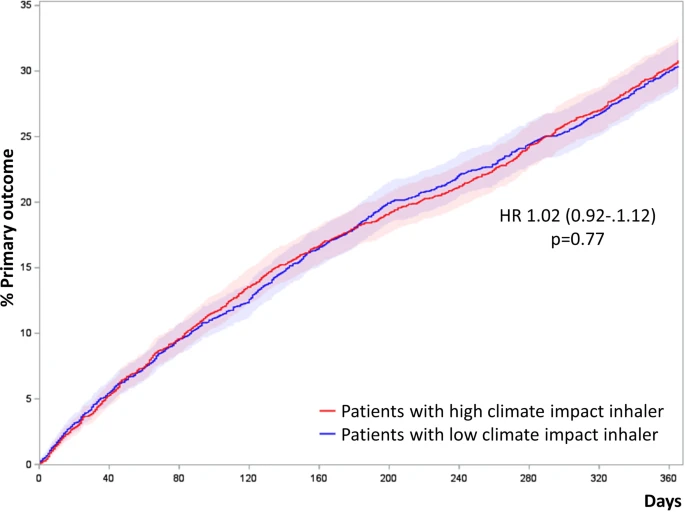
Bonnesen, B., Eklöf, J., Biering-Sørensen, T. et al. Respir Res 25, 339 (2024). https://doi.org/10.1186/s12931-024-02942-8
Abstract
Background
Chronic obstructive pulmonary disease (COPD) and asthma can be treated with inhaled corticosteroids (ICS) delivered by low climate impact inhalers (dry powder inhalers) or high climate impact inhalers (pressurized metered-dose inhalers containing potent greenhouse gasses). ICS delivered with greenhouse gasses is prescribed ubiquitously and frequent despite limited evidence of superior effect. Our aim was to examine the beneficial and harmful events of ICS delivered by low and high climate impact inhalers in patients with asthma and COPD.
Methods
Nationwide retrospective cohort study of Danish outpatients with asthma and COPD treated with ICS delivered by low and high climate impact inhalers. Patients were propensity score matched by the following variables; age, gender, tobacco exposure, exacerbations, dyspnoea, body mass index, pulmonary function, ICS dose and entry year. The primary outcome was a composite of hospitalisation with exacerbations and all-cause mortality analysed by Cox proportional hazards regression.
Results

Of the 10,947 patients with asthma and COPD who collected ICS by low or high climate impact inhalers, 2,535 + 2,535 patients were propensity score matched to form the population for the primary analysis. We found no association between high climate impact inhalers and risk of exacerbations requiring hospitalization and all-cause mortality (HR 1.02, CI 0.92–1.12, p = 0.77), nor on pneumonia, exacerbations requiring hospitalization, all-cause mortality, or all-cause admissions. Delivery with high climate impact inhalers was associated with a slightly increased risk of exacerbations not requiring hospitalization (HR 1.10, CI 1.01–1.21, p = 0.03). Even with low lung function there was no sign of a superior effect of high climate impact inhalers.
Conclusion
Low climate impact inhalers were not inferior to high climate impact inhalers for any risk analysed in patients with asthma and COPD.
